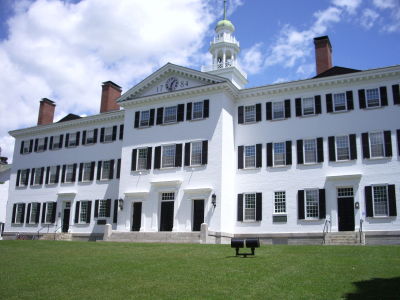“How many Dartmouth students does it take to screw in a light bulb?”
None – Hanover doesn’t have electricity.
The joke is an easy jab at Dartmouth’s remoteness and was eerily prescient on the first day of 14W, but it brings up an important question: Why did Eleazer Wheelock choose Hanover, New Hampshire as the location for Dartmouth so many years ago?
This question has often lingered in my mind while I have struggled to get to school from Louisiana. As luck would have it, I received the book Eleazer Wheelock and the Adventurous Founding of Dartmouth College for Christmas this year and was able to read it and answer this question as I waited for my plane at the gate. Fittingly enough, my plane was delayed due to snow.
At first glance, Hanover seems far from an ideal place for founding a college in 1769 America. It is difficult to access, cold, and far from major communities. But in Wheelock’s eyes, Hanover was a very appropriate location. Dartmouth needed to have abundant land with good soil, be in close proximity to Native Americans, be far from “the Temptations to the Vices,” and be in a place that would assist in acquiring a charter for the school. Hanover fit all of these necessities.
Before he founded Dartmouth College, Wheelock ran a school called the Indian Charity School in Lebanon Crank, Connecticut. This school taught both whites and Native Americans and was a predecessor for what Wheelock sought to make Dartmouth. But before starting Dartmouth, Wheelock realized that Lebanon lacked adequate space for a college.
In order for Dartmouth to reach the Native Americans it intended to educate, it needed to be sufficiently close to their lands. Also, because the costs of starting and running a college were high and there were no markets in these areas, he needed the land to be suitable for farming. Wheelock required “that a large Farm of Several Thousand Acres of and within said Grant be given to this Indian School – That the School be an Academy for all parts of useful Learning, part of it a College for the Education of Missionaries School Masters.”
He considered many possible locations for Dartmouth before settling upon Hanover. North Carolina was suggested because of its long growing season and soft soil. Along the St. John’s River in Nova Scotia was an option because it had “communication by water not only with Great Britain and the sea port towns in the Colonies, but also with Indian tribes in Canada… It is said the soil is extremely good… and the winter, as they are nearer the salt-air, not more severe, if so much, as at” New Hampshire. Other possibilities included western Pennsylvania along the Susquehanna River, Berkshire County in Massachusetts, and Albany, New York.
The various regions promoted themselves to Wheelock. People offered him land, building help, and supplies to attract him and his school to their respective communities.
Wheelock sent representatives to proposed regions to help decide where to locate Dartmouth College. Those delegates visiting New Hampshire met with governor John Wentworth, who had recently succeeded his uncle, Benning Wentworth. The Wentworths enjoyed a close relationship with Wheelock and strongly encouraged Dartmouth to come to New Hampshire. These representatives compiled a report and sent it to Dartmouth’s nascent Board of Trustees, which was based in England at the time.
But Wheelock did not wait for the Trustees’ approval. He established Dartmouth College in New Hampshire and gained a formal charter even before the Trustees could respond. His actions, obviously, did not go over well with the Trustees. “It was certainly a very wrong step for you to take without consulting us – it is the sentiment of us all that by lodging the power in other hands, it has superseded the trust here.”
Wheelock chose Hanover over many other possible New Hampshire towns. Although towns such as Haverhill, Landaff, and Orford tried to entice Wheelock, he settled upon Hanover. Accordingly, former Governor Benning Wentworth granted Dartmouth College “five hundred acres of land situate lying and being in the south westerly angle of the Town of Hanover.”
If you think that taking the Dartmouth Coach to campus is a pain, understand that the trip 245 years ago was far more arduous. From Connecticut, the trip was near 200 miles long on remote roads. Beyond what is now Charlestown, NH, the journey worsened. There were little in the way of roads, so much of the travel was through forests. The Connecticut River acted as a navigational aid. Riding on horseback, one could make the trip from Connecticut to Hanover in five or six days, but traveling by foot or with supplies lengthened the trek to “two weeks or more.”
Arriving in Hanover in 1770 offered little respite from the demanding journey. Wheelock described Hanover as a “howling wilderness,” and one early Dartmouth student noted that “the spot to be fixed upon was in a dark thicket of woods.” Accommodations were similarly Spartan. Even Wheelock lived in an eighteen square foot log hut upon first coming to Hanover. But he still saw potential in that harsh environment: “the situation is on a beautiful plain, the soil fertile and easy of cultivation.”
So the next time New Hampshire weather slows your travel to campus, or your friends refuse to visit because it’s so hard to get here, or your face freezes while you hurry to your 9L this winter, remember that things have come a long way since 1769.
–Will Duncan


Be the first to comment on "Why is Dartmouth in Hanover?"